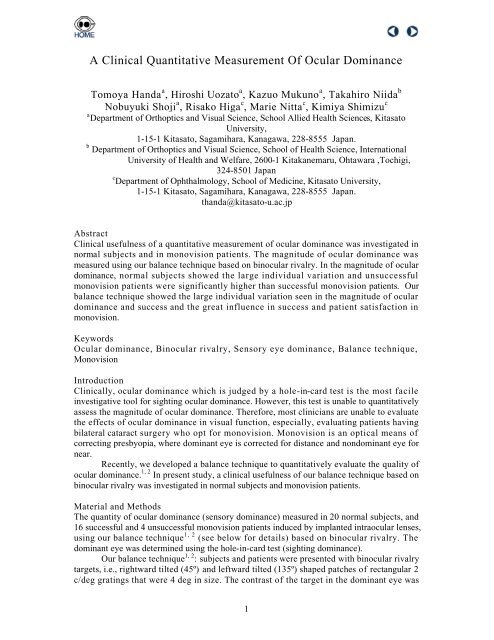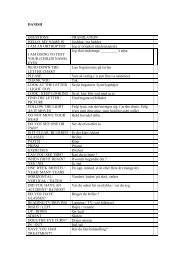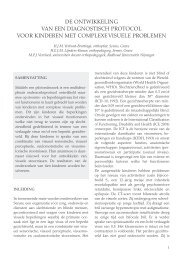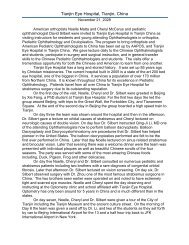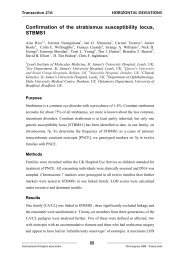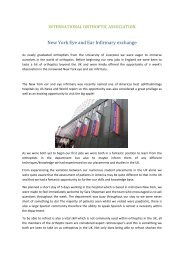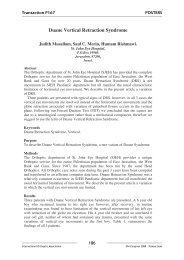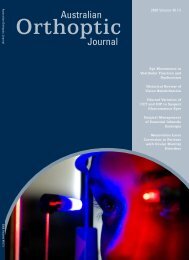Transactions from the Xth International Orthoptics Congress 2004
Transactions from the Xth International Orthoptics Congress 2004
Transactions from the Xth International Orthoptics Congress 2004
You also want an ePaper? Increase the reach of your titles
YUMPU automatically turns print PDFs into web optimized ePapers that Google loves.
A Clinical Quantitative Measurement Of Ocular Dominance<br />
Tomoya Handa a , Hiroshi Uozato a , Kazuo Mukuno a , Takahiro Niida b<br />
Nobuyuki Shoji a , Risako Higa c , Marie Nitta c , Kimiya Shimizu c<br />
a Department of <strong>Orthoptics</strong> and Visual Science, School Allied Health Sciences, Kitasato<br />
University,<br />
1-15-1 Kitasato, Sagamihara, Kanagawa, 228-8555 Japan.<br />
b Department of <strong>Orthoptics</strong> and Visual Science, School of Health Science, <strong>International</strong><br />
University of Health and Welfare, 2600-1 Kitakanemaru, Ohtawara ,Tochigi,<br />
324-8501 Japan<br />
c Department of Ophthalmology, School of Medicine, Kitasato University,<br />
1-15-1 Kitasato, Sagamihara, Kanagawa, 228-8555 Japan.<br />
thanda@kitasato-u.ac.jp<br />
Abstract<br />
Clinical usefulness of a quantitative measurement of ocular dominance was investigated in<br />
normal subjects and in monovision patients. The magnitude of ocular dominance was<br />
measured using our balance technique based on binocular rivalry. In <strong>the</strong> magnitude of ocular<br />
dominance, normal subjects showed <strong>the</strong> large individual variation and unsuccessful<br />
monovision patients were significantly higher than successful monovision patients. Our<br />
balance technique showed <strong>the</strong> large individual variation seen in <strong>the</strong> magnitude of ocular<br />
dominance and success and <strong>the</strong> great influence in success and patient satisfaction in<br />
monovision.<br />
Keywords<br />
Ocular dominance, Binocular rivalry, Sensory eye dominance, Balance technique,<br />
Monovision<br />
Introduction<br />
Clinically, ocular dominance which is judged by a hole-in-card test is <strong>the</strong> most facile<br />
investigative tool for sighting ocular dominance. However, this test is unable to quantitatively<br />
assess <strong>the</strong> magnitude of ocular dominance. Therefore, most clinicians are unable to evaluate<br />
<strong>the</strong> effects of ocular dominance in visual function, especially, evaluating patients having<br />
bilateral cataract surgery who opt for monovision. Monovision is an optical means of<br />
correcting presbyopia, where dominant eye is corrected for distance and nondominant eye for<br />
near.<br />
Recently, we developed a balance technique to quantitatively evaluate <strong>the</strong> quality of<br />
ocular dominance. 1, 2 In present study, a clinical usefulness of our balance technique based on<br />
binocular rivalry was investigated in normal subjects and monovision patients.<br />
Material and Methods<br />
The quantity of ocular dominance (sensory dominance) measured in 20 normal subjects, and<br />
16 successful and 4 unsuccessful monovision patients induced by implanted intraocular lenses,<br />
using our balance technique 1, 2 (see below for details) based on binocular rivalry. The<br />
dominant eye was determined using <strong>the</strong> hole-in-card test (sighting dominance).<br />
Our balance technique 1, 2 : subjects and patients were presented with binocular rivalry<br />
targets, i.e., rightward tilted (45º) and leftward tilted (135º) shaped patches of rectangular 2<br />
c/deg gratings that were 4 deg in size. The contrast of <strong>the</strong> target in <strong>the</strong> dominant eye was<br />
1


